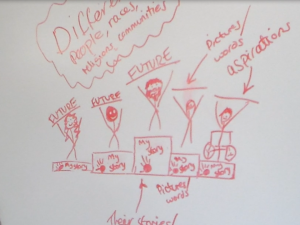Listening to the stories of Holocaust survivors is always inspirational, but today (Tuseday 25th September) was more enlightening than usual.
Along with colleague Rosie Sheldrake, I took a group of Year 9 students to an oral history event at Essex University, in memory of the late Dora Love. The original plan was to give students access to quality material for a Holocaust project that we would define later, however, as the day unfolded, we decided to hand over the whole process of project design to the students – something we have not done before.
Below is a quick explanation of how we went about it…
Firstly, we asked what elements of the talks had really struck students and why. Next we explored the title of the session, ‘Building Bridges,’ and began to form these vague words into ideas.
We then divided the students into four smaller groups and asked them to formulate an idea for a project. The only restriction was that it must comply with the first four of Steinberg’s ‘six A’s’ of project based learning: authentcity, academic rigour, applied learning and active exploration. We were confident that they would come up with some decent ideas, but I did not know whether they would be able to make it rigourous enough to stand up to school and real world assessment. These Year 9s were more than up to the task and came up with some fantastic ideas.
Before sharing we got students to SCAMPER their project ideas to firm them up and explore avenues that had not occurred to them in the initial planning. Essentially it took the place of a good project tuning. While not quite as as effective as a tuning, it did force groups to scrutinise their ideas and three of the groups made substantial changes. They then posted up their final ideas on a whiteboard for critique.
You can listen to the final presentation of ideas below:
HDV_0210
HDV_0211
HDV_0212
HDV_0213
Within two hours students had created a project idea that combined many of the elements outlined above. The main idea is to create a set of plinths in front of a mural. These plinths will contain a history of different types of discrimination. People who have experienced abuse will be invited to come and stand on the plinths, tell their story and record their hopes for the futures. All this will be captured on a rolling film. This is ambitious and exciting, but it makes our genuinely engaging learning. They will need assistance with the managing of adult relationships and assessment, but we are planning to give much of this responsibility to Year 12 student leaders.
What I like most about this project is that the learning will unfold as the project progresses; students can create the history plinths, but have no idea who will come and tell their stories. It will create a real bond with the community and foster attitudes of understanding. If she were still with us, Dora Love would be incredibly proud.
